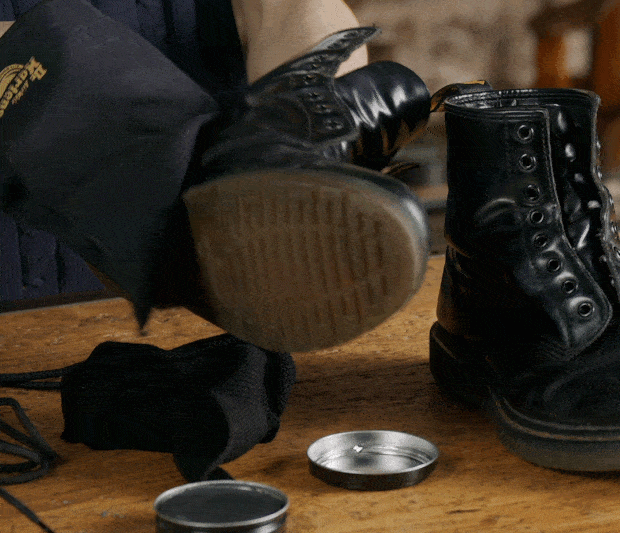For the leather footwear that I use, I polish them with Bundeswehr boot polish once a week and brush molten lard into the once a month.
The old tale goes that the lard or other animal fats such as tallow help soften and condition the leather as well as waterproof it somewhat, which prevents the leather becoming brittle and cracking.
However I've seen it be argued that animal fats such as lard with weaken and rot the leather and this is the reason fats are removed from leather in the tanning process.
So what is the truth? Is the old-as-time practice of greasing up your boots beneficial for them or am I ruining them? Or am I being lied to so that I have to but new boots sooner?




OP here. I'm reading all sources available on Google and they seem divided on this question...
Depends on the moisture content of the fat.
It's microbes and fungi that destroys leather, and they need moisture
If the fat has been dehydrated properly then it will work. If it's still got a lot of water emulsified in it then it will support leather degradation.
Boots don't last forever, but they can last many years with proper maintenance.
Modern manufacturing tends toward replacement rather than repair so the leather that is used may not be good enough to last even with maintenance.
Theres too many variables, which is why the internet craps on forever about it.
Just try it and find out.
>Bundeswehr boot polish
The lidlhog strikes again.
Top grain leather needs regular greasing to remain usable as it will dry and crack otherwise, it makes it waterproof too. I recommend you use a specific product made exclusively from natural greases, petroleum ones penetrates too much which will give issues or outright ruin the piece.
You don't need to melt it, scoop a little with your fingers and pull it with your palm, covering the outside of the boots completely with a thin uniform veil, insisting on folds and seams.
Once a month is too much, normally once or twice or more a year, depending on usage.
Polish doesn't need to be given weekly, next time simply rub them with a rag; you should reapply polish only when it becomes impossible to shine them like this. Too much care ruins the boots.
I have an old manual stating you can use a mixture of lard, honey and beeswax in equal parts in lieu of grease, try that at your own risk.
The leather cream I use is by T.H.Geyer allegedlly presently used by the German Armed Forces and contains small amounts of silicone.
I don;t know what the contents of this boot polish are but it comes in a tube and is squeezed out in semi-liquid form like toothpaste.
I would never use tin waxes like picrel. Petroleum-based, heavy waxes. I have indeed had experiences were tin waxes impregnate themselves into the leather in the form of a heavy coating.
https://www.thgeyer.com/en/ingredients/portfolio/leather-care
Mind giving your opinions on this product? This is what I use, says FLORAL wax-based. When applied it doesn't really shine the shoe very much but I trust it will protect it.
I normally use Kiwi, I would say most polish products are probably acceptable. I also used a Haix one which is probably similar to that but only a couple times.
Normal polish will indeed form a layer, that's the point in it, though it would probably clog and destroy any membrane unlike germ creams that seem to avoid that, unsurprisingly they shine less.
Similar to the one you use, if not identical.
>FLORAL wax-based.
Probably a seed oil of some kind. The only seed oil I've used on leather was shea butter, which caused a wax bloom a few months down the road.
I think it's just a marketing name.
The "problem" with petroleum products is that they will always contain a certain amount of wax that will bloom on the surface of the leather over time and "require" buffing or polishing. Animal fats generally don't do this unless the wax is added in some manufacturing process when you buy Dr. SoandSo's super secret product. The wax helps keep salt stains out. I'd use animal fat on leather i was handling all the time, like wallets or notebook covers. I'd use synthetic for winter boots or axe sheathes.
Animal fat rec.: pure mink oil
synthetic rec.: dubbin or snoseal
Are you saying that I shouldn't use polish at all? Only animal fats? How do I shine my boots then? I use T.H. Geyer BW boot CREAM on my leather.
just use straight bees wax.
fats can mould if stored above freezing
I visited a traditional logging boot factory and they recommended only beeswax on their products since animal fats tend to break down the leather over time
Melted deer fat brushed on
Look up brain tanning.
Obenauf's is the shit, use it for all of my boots. It's what forestry and wildland firefighters swear by, it's beeswax and propolis based and makes boots decently waterproof due to the wax soaking in to the leather. I've heard about the fats causing the leather to rot and as far as I know beeswax doesn't have that effect.
I read this as "animal farts" and thought that OP was out there collecting farts from animals somehow.
Animal fats and most plant oils will eventually go rancid. It may take years. If you wear out and replace your boots it won't matter.